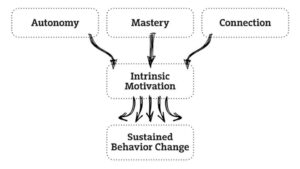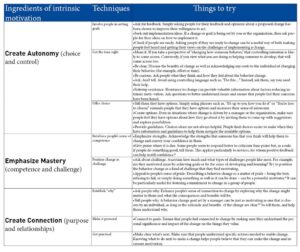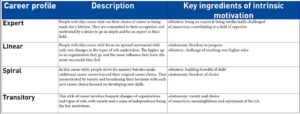“I put a dollar in one of those change machines. Nothing changed.”
George Carlin (American comedian)
Though it is hardly ever listed in job descriptions, changing employees’ behavior is an important part of any manager’s work. Whether it is helping people to develop and improve at what they do or getting them to do new things in new ways, enabling behavior change just comes with the territory. And for many managers, it is the toughest challenge they face.
It is not that they do not know what needs to change. In a study we conducted with over 500 managers from around the world, we asked leaders how confident they were about their ability to help others identify and understand which behaviors they needed to alter to improve performance. Nearly three-quarters said they found this easy. When we asked how confident they were about giving feedback, roughly the same percentage said they knew how to do that too. Yet only around a third felt sure about which techniques to use to help people evolve, and fewer than 10% expressed confidence about making the adjustment stick over time. It is not what behavior to change but how to do so that they found perplexing. It is little wonder, then, that less than half of the managers we surveyed believed that attempts to modify behavior actually work.
So what is the problem? As we discuss in our recent book,1 it takes more than just knowing what behaviors must be altered to make it happen. Unless workers have the requisite abilities, inner resources (such as self-belief and resilience) and supportive work environments, it is difficult to make or sustain meaningful change. However, even before we consider all of these, the element that we need to think about first is motivation: Do people want to change? While managers understand that they need to motivate employees to do so, it is not always clear how they should go about it. Indeed, our survey showed that only 28% felt confident about their ability to stimulate people to change. It may seem odd that this should be the case, given the enormous attention and resources that organizations dedicate to incentive systems. Most often, however, these incentives take the form of rewards or penalties – often referred to as extrinsic motivators. While there is plenty of evidence that these can indeed work to promote behavior change, they are only half of the picture.

Intrinsic motivation: Fostering internal commitment
The more neglected half of motivation is what psychologists call intrinsic motivation. Intrinsic motivators drive behavior change by tapping into internal feelings to act for reasons that we find inherently enjoyable or fulfilling. It has gained increasing attention in the academic and popular literature in recent years, and for good reason. Performance, productivity and sheer enjoyment of work have all been found to be greater in people with higher levels of intrinsic motivation,2 as have related behaviors such as initiative and concentration.3 This appears to hold true for behavior change, too. People with higher levels of intrinsic motivation for particular behaviors are better able to do those things and to sustain them over time.4
Decades of research on what drives this type of positive internal commitment shows that intrinsic motivation involves three essential factors: Autonomy, Mastery and Connection.
• Autonomy refers to the feeling of having a choice in what one does and not being controlled by others
• Mastery is about feeling competent in one’s abilities mixed with the right level of challenge and achievement
• Connection has to do with experiencing a sense of purpose in what one does as well as how one relates to other people
There is strong evidence suggesting that satisfying this trio of inner needs contributes to intrinsic motivation, which in turn leads to sustained behavior change over time (see Figure 1). As we discuss later, individuals may be motivated to different degrees and in various ways by these three factors. Personality and cultural background can influence which elements people find most motivating. So, finding what works requires combining these elements in a way that is most effective for a given individual.

To increase intrinsic motivation for change, managers therefore need to foster employees’ feelings of Autonomy, Mastery and Connection with regard to the desired change. What we discovered in our research is that, at some level, managers have an intuitive understanding of these factors but often fail to apply them in practice. When we asked about what motivates them and others, managers often mentioned elements related to Autonomy, Mastery and Connection (though usually not in these terms). However, when asked what they actually did to stimulate their direct reports, most of them mentioned things such as merit increases and bonuses, which are linked to extrinsic rather than intrinsic sources of motivation.
The Progress Principle
In research conducted with more than 230 workers whose jobs required creative productivity, Teresa Amabile and Steven Kramer examined intrinsic motivation and what managers could do to foster it. What they discovered was that, for this group of creative knowledge workers, the single most important factor was the sense that they were making progress in meaningful work. Even small wins or reaching minor personal milestones could have a huge impact on workers’ mood, emotions and levels of intrinsic motivation, leading to higher productivity. The sense of making personal progress is strongly linked to the needs for Autonomy, Mastery and Connection. The findings had clear implications for how managers should focus their efforts to catalyze and nourish this sense of daily progress. They found that a few simple actions could have a significant impact. The first was to establish a positive climate for a team’s work. Another involved staying attuned to everyday activities and progress – not just project deliverables. Effective managers also targeted their interventions (e.g. removing barriers or clarifying goals) in response to recent events experienced by individuals or teams to encourage a sense of progress. Finally, they made themselves resources rather than micromanagers – frequently checking in with people rather than checking up on them. These measures proved beneficial in improving the inner work lives of employees, boosting intrinsic motivation and organizational performance.
Table 1 summarizes a number of actions that managers can take in the course of day-to-day work to increase employees’ intrinsic motivation for behavior change.

As noted above, different people will relate to each of these factors in distinct ways. Research demonstrates that age, gender, national culture and role in the organization can influence the relative importance of Autonomy, Mastery and Connection in motivating people. While finding what works for each person requires some effort, we are not suggesting that managers need to construct deep psychological profiles of employees in order to be effective. As already mentioned, most of the actions that managers can take are relatively straightforward. It is important, however, to stay attuned to individuals and teams to get a sense of what things can have the most impact.
One way that managers can do this is to recognize how different employees relate to their work. The view that individuals take of their own careers and the way they approach risk can affect what they find motivating (see Table 2). By understanding these personal attitudes and preferences,6 managers can emphasize the factors that are most apt to produce internal commitment to change.

Another characteristic that can influence what individuals find motivating relates to their tendencies to adopt a “promotion-focused” vs. a “prevention-focused” mindset. Someone who adopts a promotion approach plays to win and may be more likely to take chances, seize opportunities and be creative. Responding to their need for autonomy and providing opportunities for challenge and growth may be most effective in fostering their commitment to change. By contrast, someone who takes a prevention approach tries to avoid failure and may prioritize thoroughness and planning in order to minimize mistakes. For this type of worker, intrinsic motivation may be driven by boosting their sense of competence and security. Again, no single “recipe” is likely to be best in all cases. But recognizing the importance of Autonomy, Mastery and Connection and tuning in to how these “ingredients” contribute differently to individuals’ intrinsic motivation can help managers concoct winning combinations.
Keeping the balance
Generating internal commitment to change is not the only way for managers to influence behavior. As we argue elsewhere,7 there is strong evidence that extrinsic motivators can also be useful as part of the manager’s toolkit when used correctly, so we should not let the pendulum swing too far. We know, however, that motivation based purely on reward and punishment is hard to sustain over time and that most organizations pay insufficient attention to the potential power of intrinsic motivation. One reason for this overreliance on extrinsic motivators may be that reward and punishment systems can be relatively easy to put in place. Once established, they may operate largely without the intervention of line managers, who can “outsource” the process to HR or Finance functions.
Stimulating behavior change can involve significant demands on already overloaded managers in terms of time and skills required. This may be part of the reason that those we surveyed seemed gloomy about the prospects of making change work and making it stick. The good news is that there is a lot of solid evidence about what works, when it works and with whom it works that managers can draw on. At its core, fostering intrinsic motivation is about helping employees become more productive, engaged and happier in their work. Over the longer term, this contributes to better organizational performance and enables workers to develop and lead more independently. We hope that managers find this prospect motivating!
References
1 Kinley, N. and S. Ben-Hur. Changing Employee Behavior: A Practical Guide for Managers. London: Palgrave: MacMillan, 2015.
2 Grant, A.M. “Does Intrinsic Motivation Fuel the Prosocial Fire? Motivational Synergy in Predicting Persistence, Performance, and Productivity.” Journal of Applied Psychology, 93(1), 2008: 48; Froiland, J.M. “Parental Autonomy Support and Student Learning Goals: A Preliminary Examination of an Intrinsic Motivation Intervention.” Child and Youth Care Forum, 40(2), 2011a: 135-149; Kanfer, R. and P.L. Ackerman. “Motivation and Cognitive Abilities: An Integrative/ Aptitude-Treatment Interaction Approach to Skill Acquisition.” Journal of Applied Psychology, 74(4), 1989: 657.
3 Thomas, K.W. and B.A. Velthouse. “Cognitive Elements of Empowerment: An “Interpretive” Model of Intrinsic Task Motivation.” AcademyofManagementReview, 15(4), 1990: 666-681; Blais, M.R., N.M. Brière, L. Lachance, A.S. Riddle, and
R.J. Vallerand. “L’inventaire des Motivations au Travail de Blais.” RevueQuébécoisedePsychologie, 14(3), 1993: 185-215.
4 Ryan, R.M., H. Patrick, E.L. Deci, and G.C. Williams. “Facilitating Health Behaviour Change and its Maintenance: Interventions Based on Self-determination Theory.” The European Health Psychologist, 10(1), 2008: 2-5; Ryan, R.M. and J.P. Connell. “Perceived Locus of Causality and Internalization: Examining Reasons for Acting in Two Domains.” Journal of Personality and Social Psychology, 57(5), 1989: 749.
5 Amabile, T.M. and S.J. Kramer. The Progress Principle: Using Small Wins to Ignite Joy, Engagement, and Creativity at Work. Harvard Business Review Press, 2011.
6 Driver, M.J. “Career Concepts and Career Management in Organizations.” Behavioral Problems in Organizations, 79-139, 1979.
7 Ben-Hur, S and N. Kinley. “Changing Employee Behavior: Do Extrinsic Motivators Really Not Work?” Tomorrow’s Challenges, IMD, May 2015.
8 Ryan, R.M. and E.L. Deci. “Intrinsic and Extrinsic Motivations: Classic Definitions and New Directions.” Contemporary Educational Psychology, 25(1), 2000: 54-67.
9 Katzenbach, J. “Pride: A Strategic Asset.” Strategy & Leadership, 31(5), 2003: 34-38.
10 Brown, S.P. and T.W. Leigh. “A New Look at Psychological Climate and its Relationship to Job Involvement, Effort, and Performance.” Journal of Applied Psychology, 81(4), 1996: 358; Kahn, W.A. “Psychological Conditions of Personal Engagement and Disengagement at Work.” Academy of Management Journal, 33(4), 1990: 692-724.
Research Information & Knowledge Hub for additional information on IMD publications
Research Information & Knowledge Hub for additional information on IMD publications













